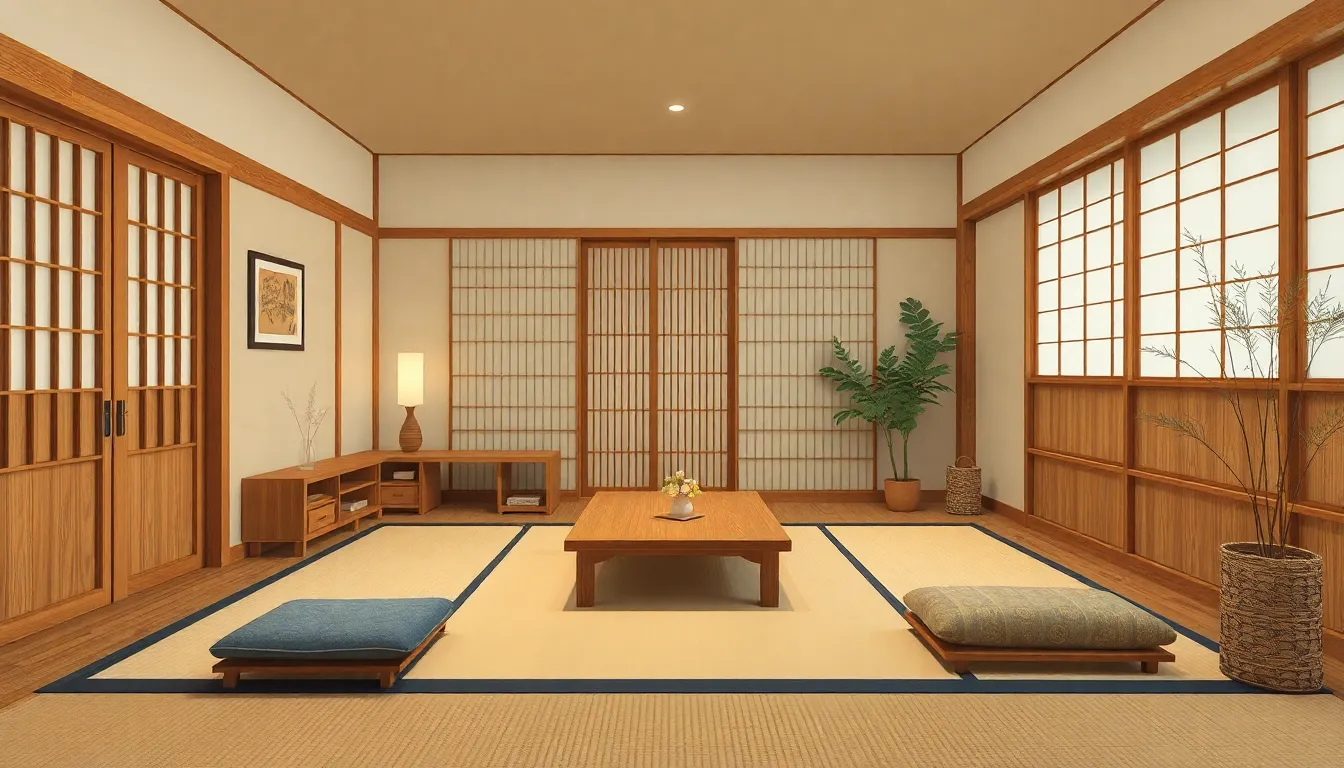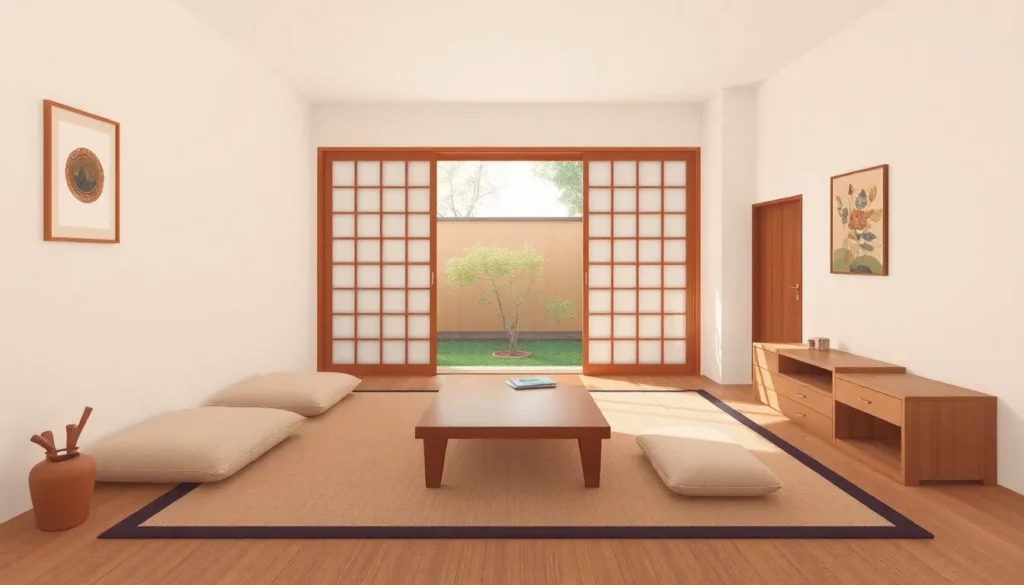Japanese furniture design isn’t just about aesthetics; it’s a harmonious blend of simplicity, functionality, and a dash of Zen. Picture this: a beautifully crafted tatami mat, minimalist lines, and a sense of calm that makes your living room feel like a serene retreat. It’s no wonder that this style has captured hearts and homes around the world.
But wait, there’s more! Japanese design principles teach us that less truly is more. Who needs a cluttered space when you can have elegant pieces that serve multiple purposes? With clever storage solutions and an emphasis on natural materials, Japanese furniture transforms any space into a tranquil oasis. So, if you’re ready to elevate your home decor and experience the art of minimalism, buckle up! It’s time to dive into the world of Japanese furniture design and discover why it’s the perfect antidote to modern chaos.
Japanese Furniture Design
Japanese furniture design embodies minimalist aesthetics and practical functionality. Characterized by clean lines, this style promotes a sense of tranquility and calmness. Simplicity remains a core principle in these designs, allowing spaces to feel open and uncluttered. Natural materials such as wood, bamboo, and rice paper dominate, emphasizing a connection to nature.
Multifunctional pieces frequently appear in Japanese interiors. Furniture serves multiple purposes, enhancing space efficiency. Tatami mats provide seating and sleeping options, while low tables accommodate dining and tea ceremonies seamlessly.
Each element within this design philosophy reflects the cultural importance of harmony. Balance between furniture and space ensures that design elements complement rather than overpower. Aesthetics often align with seasonal changes, creating a dynamic living environment.
Innovative storage solutions enhance the overall functionality of Japanese furniture design. Hidden compartments and low profiles help maintain cleanliness, reinforcing the importance of organization. Spaces frequently transition from public to private seamlessly, catering to varying social needs.
Traditional craftsmanship plays a significant role in brand identity. Artisans employ techniques passed down through generations, preserving authenticity and quality. Collaborative efforts between contemporary designers and skilled craftsmen introduce modern interpretations of classic forms.
The essence of Japanese furniture design resides in its ability to create serene living spaces that foster mindfulness and simplicity. Embracing these principles can transform homes into sanctuaries, offering respite from the modern hustle.
Historical Influences

Japanese furniture design draws heavily from historical contexts, combining ancient traditions with modern influences.
Traditional Aesthetics
Traditional aesthetics in Japanese furniture reflect simplicity and elegance. Clean lines characterize forms, showcasing minimal ornamentation. Natural materials such as wood, bamboo, and rice paper play essential roles, enhancing the inherent beauty of each piece. A focus on craftsmanship ensures each item embodies quality and attention to detail. Functionality remains central, with designs offering practicality without sacrificing style. The use of tatami mats illustrates how furniture adapts to daily life needs. Spaces become harmonious through thoughtful arrangements that encourage calmness and a connection to nature.
Cultural Significance
Cultural significance in Japanese furniture design stems from deep-rooted philosophies. Concepts like wabi-sabi embrace beauty in imperfection, celebrating the transitory nature of life. Furniture often serves to create a tranquil environment, fostering mindfulness. Shared spaces, such as communal dining tables, symbolize unity and connection. The relationship between furniture and space highlights a respect for natural elements, reflecting cultural values that prioritize harmony. Historical influences also emerge from Japanese tea ceremonies, which emphasize simplicity and intentionality in daily rituals. Each piece carries meaning, enriching both the living environment and the cultural narrative.
Key Characteristics
Japanese furniture design is defined by its essential qualities of simplicity, functionality, and a Zen-like calmness. These characteristics cultivate serene living environments through minimalist aesthetics and practical designs.
Material Usage
Natural materials form the cornerstone of Japanese furniture. Wood, bamboo, and rice paper feature prominently, creating a connection with nature. Each material contributes to warmth and authenticity in the design. Sustainability also plays a significant role, with environmentally friendly sourcing becoming increasingly important. Artisans select materials carefully, ensuring that textures and colors promote tranquility in interior spaces.
Minimalism and Functionality
Minimalism drives Japanese furniture design, emphasizing clean lines and uncluttered spaces. Each piece serves multiple functions, enhancing efficiency in smaller living areas. Tatami mats illustrate this concept, acting as seating during the day and beds at night. Thoughtful designs ensure that every item complements the surroundings without overwhelming them. In this style, simplicity fosters mindfulness, allowing for a harmonious living experience that prioritizes peacefulness and practicality.
Modern Trends in Japanese Furniture Design
Modern Japanese furniture design embraces innovation while respecting tradition. Designers fuse contemporary aesthetics with classic elements, creating pieces that appeal to diverse tastes.
Fusion with Contemporary Styles
Contemporary Japanese furniture blends traditional craftsmanship with modern design principles. Clean lines and functional forms define this approach, appealing to urban dwellers. Natural materials remain integral, enhancing visual appeal and sustainability. Designers often incorporate unexpected elements like metal or glass, creating striking contrasts. This fusion celebrates both heritage and modernity while adapting to current lifestyles.
Sustainable Practices
Sustainability plays a crucial role in modern Japanese furniture design. Designers prioritize eco-friendly materials, sourcing wood from responsibly managed forests. Reclaimed materials find new life in innovative furniture pieces, enhancing their uniqueness and reducing waste. Additionally, traditional joinery techniques minimize the need for adhesives, promoting durability and longevity. Many artisans embrace minimalism, ensuring that each piece serves a purpose while reducing excess consumption. Sustainable practices resonate globally, aligning with the growing demand for environmentally conscious design.
Notable Designers and Brands
Japanese furniture design boasts influential designers and renowned brands that shaped its contemporary landscape.
Tansu is a notable brand, celebrated for crafting traditional Japanese storage solutions that combine functionality with aesthetic appeal. They pay homage to historical styles while incorporating modern sensibilities.
Nitori, often referred to as the “IKEA of Japan,” offers affordable yet stylish furniture, emphasizing functionality for urban living. Their designs reflect minimalism and cater to a variety of tastes, bridging the gap between tradition and modernity.
Kokuyo stands out for its innovative office furniture, promoting productivity and comfort. The brand integrates workspace efficiency with the essence of Japanese design, focusing on clean lines and practicality.
Designer Tadao Ando merges architecture and furniture design seamlessly. Known for using concrete and natural materials, his furniture exemplifies simplicity while fostering a connection to nature.
Another significant designer, Shigeru Ban, focuses on sustainability in his work. His use of recycled materials and innovative techniques exemplifies modern Japanese design principles while addressing environmental concerns.
Muji, recognized for its minimalist aesthetic, offers a range of household items and furniture that emphasize simplicity and quality. Each piece reflects the brand’s philosophy of removing distractions, creating serene home environments.
Wajima lacquerware offers exquisite craftsmanship rooted in tradition. This artisan brand specializes in beautifully lacquered wooden items, demonstrating the rich heritage of Japanese craftsmanship.
Each of these designers and brands contributes uniquely to the evolution of Japanese furniture design, reflecting its core principles of simplicity, functionality, and harmony with nature.
Conclusion
Japanese furniture design stands as a testament to the power of simplicity and functionality. Its ability to create serene living spaces resonates deeply in today’s fast-paced world. By embracing natural materials and innovative designs, it fosters a connection to nature while promoting mindfulness.
The blend of traditional craftsmanship with modern aesthetics allows for a unique expression that appeals to diverse tastes. As more individuals seek to cultivate tranquility in their homes, the principles of Japanese design offer a refreshing approach to interior spaces. Ultimately, integrating these elements can transform any environment into a peaceful retreat, encouraging harmony and balance in everyday life.

